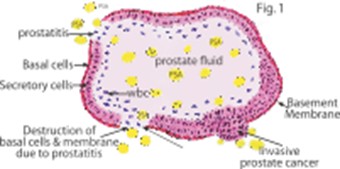


Prostate Specific Antigen (PSA) was first introduced around 1988, and since then, it is being used as a follow-up tool for Prostate Cancer therapy up to now. But the use of PSA for screening and early detection of Prostate Cancer starting 1994 has become controversial in two ways. The first controversy is whether PSA test can really accurately detect Prostate Cancer or is PSA's detection of the cancer merely incidental. PSA result has too many variables. Its sensitivity and specificity are less than ideal. Yet, we want to rely on it with our lives. The second controversy is whether screening with PSA, which may lead to early diagnosis of Prostate Cancer, is really beneficial or is it detrimental to the patients. It's sad that despite recent studies, these controversies would remain a debated medical issue in modern times. What is noteworthy is that PSA, despite being around for almost 3 decades, is still hardly understood. The most that people know about it are the pros and not the cons. My years of experience in the treatment of Prostatitis and readings of various studies on PSA and Prostate Cancer have afforded me a view of the other side of the coin. I'm doing my share in disseminating information that there is another side of the coin other than what is generally said, in the hope of creating awareness and understanding.
I. What is Prostate Specific Antigen (PSA)
PSA is a serine protease produced by both normal and malignant Prostate epithelial cells, which is secreted into the Prostatic Fluid to liquefy the semen.
PSA is not specific to the Prostate as the name connotes and therefore is misleading. As early as 1997, PSA has been detected in the male's Urethral Glands, Urinary Bladder, Breast Tissues, Salivary Glands and even in the blood of a female. Furthermore, PSA is also not specific to Prostate Cancer. The purported normal serum level of PSA is 0-4 ng/mL. As the PSA test improved through the years in detecting lower levels of PSA in the blood, the more non-specific it has become (Diamandis, 1997) and labeling it as a tumor marker poses a risk of overdiagnosis of Prostate Cancer. How then can we peg a normal value on PSA when it is not specific to the Prostate nor to Cancer.
II. What Causes the Elevation of PSA?
The most widely accepted theory is the "leak phenomenon" (Brawer et al., 1989).
Normally, PSA is contained in the individual glands of the Prostate and only minute levels are detectable in the blood. Various studies have shown that an elevation of blood PSA level has to be due to a leak or a break in the basal cells caused by Prostate Diseases such as Prostatitis, an Invasive Cancer (Fig. 1), and to a certain extent in conditions that increases the number of cells in the Prostate such as BPH or where there is inflammation around the Urethral Glands such as UTI (Diamandis, 1997). It is, therefore, not advisable to do a PSA test when a patient has UTI as it could remarkably raise the PSA level with no relevance to the Prostate Condition

Prostatitis is the Most Common Cause of Elevated PSA
Virtually 100% of men who were biopsied because of elevated PSA have Prostatitis (Neal et al., 1992). Prostatic inflammation (acute and chronic) and Urinary Retention can cause PSA elevations to variable degrees (Dalton et al., 1989). An acutely inflamed or infected Prostate can send the PSA soaring to a stratospheric 50 to 100 ng/mL, or even higher (Scardino, 2005).
III. PSA use for Screening Cancer is Controversial
The routine use of DRE and PSA testing in asymptomatic men as a means of reducing Prostate Cancer mortality by earlier detection and treatment remains controversial. The US Preventive Services Task Force recommends against the use of PSA-based screening for Prostate Cancer as there is moderate or high certainty that the service has no net benefit or that the harm outweighs the benefits (www.annals.org, July 2012).
The 2012 US Prostate, Lung, Colorectal and Ovarian (PLCO) Screening Trial done by Andriole et al. showed there was no advantage in early detection of those who had Prostate Cancer and that it may even be detrimental to the patient as it revealed that there were more deaths from Cancer in those who had PSA screening compared to those who were not screened.
nother study published in 2012 by Wilt et al., called PIVOT, showed no difference in the 12-year survival and mortality rate among the men who had Surgery against those men who were not treated and were just Observed.
Though PSA may help detect cancer by chance at an early stage, it may not increase overall survival rates and may subject many men to unnecessary treatment. The treatment he may receive may do more harm than the cancer would have.
IV. Potential Risk of Early Detection of Prostate Cancer
According to Pathologists Dr. Cristina Magi-Galluzzi, Dr. Ming Zhou and Jonathan Epstein, "The diagnosis of Prostate Cancer, especially when present in small amounts, is often challenging. Before making the diagnosis of Prostate Carcinoma, the Pathologist should consider the various Benign lesions that may mimic Prostate Cancer. Most of the mimickers are easily recognized, but they may represent a challenge when dealing with limited sampling in thin-core needle Biopsies." (Genitourinary Pathology, 2007)
Two of the potential mimickers of Prostate Cancer are Prostatitis and Proliferative Inflammatory Atrophy (PIA) which is said to be the most common look-alike of Prostate cancer and is usually associated with Chronic Prostatitis.
Thus, to continue using PSA routinely as a screening test may subject most men to unnecessary Biopsies and expose them to the potential risk of overdiagnosis of Prostate Cancer. This means diagnosing an "Indolent Cancer," which is a cancer that is said to be slow-growing and which may not even manifest in the patient's lifetime.
What is worse is to diagnose a cancer that does not exist, but is just a mimicker or a look-alike. That would be the greatest disservice one can give to a patient.
V. What is the Significance of an Elevated PSA?
An Elevated PSA signals something may be grossly wrong that needs urgent attention. Although most Prostatitis have normal PSA levels because the basal cells are normally resistant to destruction from Infectious agents, but through time, these basal cells could be destroyed by virulent organisms, causing leakage of PSA. Thus, an elevation should serve as an omen that you are dealing with a potent organism strong enough to damage the basal cells that, if left untreated, could create much destruction to the Prostate and may lead to Cancer in a shorter time.
VI. How to Address an Elevated PSA?
Diagnosing and Treating Prostatitis are necessary steps in addressing an elevated PSA in the absence of a palpable mass on Digital Rectal Exam (DRE), whereby a physician inserts a gloved and lubricated finger inside the anus. The key to diagnosing Prostatitis is through Prostate Massage to collect and examine the Expressed Prostatic Secretion (EPS) or Prostate Fluid by Wet Mount, Gram Stains and Cultures including Ureaplasma and Mycoplasma bacteria as well as Direct Fluorescence Antibody (DFA test) for Chlamydia by Immunofluorescence Microscopy.
Prostatitis is treatable medically with culture-based antibiotics combined with thrice-weekly Prostate Massage. This is to drain out the infected Prostate Fluid or open clogged glands of the Prostate thereby allowing antibiotics to enter these glands as new fluid refills them after the Prostate Massage. Otherwise "there is an inherent failure of the antibiotics to penetrate the prostate" (Stamey & Meares, 1978) without a Prostate Massage.
VII. Drawbacks of the 1 Month Antibiotic Trial
Treatment of Elevated PSA
A one month antibiotics trial to treat Prostatitis has been suggested by some doctors to lower the PSA back to normal in an effort to save the cancer-free men from Biopsy which is a laudable effort. But sad to say, this may often be inadequate because antibiotics do not readily penetrate most Infected or Inflamed Glands of the Prostate without Prostate Massage, depending on the degree of inflammation or thickness of the fluid.
Often Prostatitis is caused by multiple organisms such as Bacteria, Fungus, Virus, etc., and may need different antibiotics or anti-fungals which would necessitate several phases of treatment regiment.
Thus, the 1 month antibiotic trial is likely doomed to fail from the very onset or may become a token of an effort to spare the cancer-free men from the Biopsy ordeal.
Elevated PSA and Biopsy
Many men with elevated PSA who turned out negative for Prostate Cancer on Biopsy are not being diagnosed or treated for Prostatitis. Since studies have shown that Prostatitis is a far more common cause of Elevated PSA than Cancer and in view of the fact that it is not Cancer, a diagnosis of Prostatitis ought to be pursued, and if warranted, it should be adequately treated otherwise the PSA could remain elevated and lead to more unnecessary Biopsies or Cancer may eventually develop from the Chronic Infection.
A history of Prostatitis is apparently linked to the development of Prostate Cancer, suggesting that quick, effective treatment of Prostatitis could reduce the rate of Prostate Cancer (N. Daniels, Urology Times 2004).
Health Topics
-----













